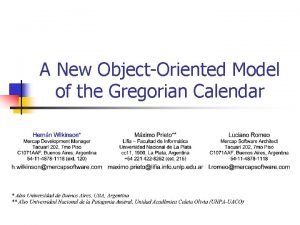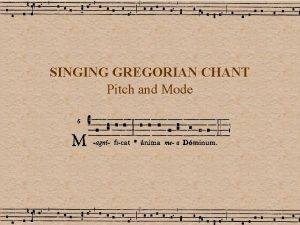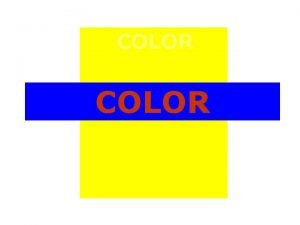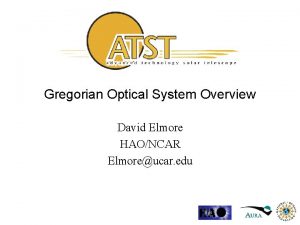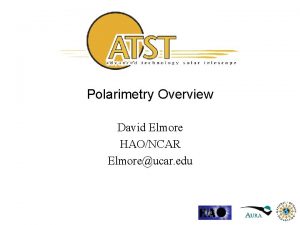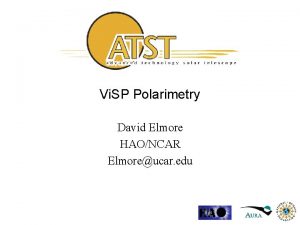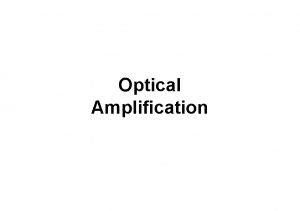Gregorian Optical System Overview David Elmore HAONCAR Elmoreucar












- Slides: 12

Gregorian Optical System Overview David Elmore HAO/NCAR Elmore@ucar. edu

Purpose of Gregorian Optical System (GOS) • Bandpass limiting – Needed to protect some types of polarization calibration/modulation optics • Polarization calibration – Perform calibration before any highly polarizing telescope optical elements • Polarization modulation – Perform polarization modulation before any highly polarizing optical elements • Secondary focus functions May 27 -28, 2004 Gregorian Optical System Overview 2

GOS Issues • Must meet polarimetry requirements for every wavelength range • Located before any high angle reflections, therefore just before and including Gregorian focus • Space is limited • Gravity vector changes • Optical dimensions grow with increasing distance from Gregorian focus May 27 -28, 2004 Gregorian Optical System Overview 3

More GOS Issues • Requires active temperaure control of some optical elements • Should be kept clean May 27 -28, 2004 Gregorian Optical System Overview 4

The Five Stations • Band pass limiting – Limit solar flux or spurious light • Calibration Linear Polarizer – Columns 2 and 3 of polarimeter response matrix • Calibration Retarder – Column 4 of PRM and measurement of telescope Stokes vector • Polarization Modulator – After calibration optics, before first fold mirror • Gregorian focus – Alignment masks, LASER beam insertion, Wavefront sensor pick off … May 27 -28, 2004 Gregorian Optical System Overview 5

Station Options • Allocate station selections by wavelength range (6) – my choice – Observing options available for all wavelengths without manually changing optical elements • Allocate station selections by function (3) – – Sufficient choices for the ‘current’ observing run Smaller Mechanically simpler Frequent access to GOS to change optics May 27 -28, 2004 Gregorian Optical System Overview 6

Bandpass Limiting • Reject unwanted wavelengths to reduce flux on following calibration and modulator optics – – – Clear Dark (mirror) UV Vis/NIR Mid IR Far IR May 27 -28, 2004 Gregorian Optical System Overview 7

Calibration Linear Polarizer • Stokes calibration requires input of known linear polarization – – – Clear UV Vis/NIR a Vis/NIR b Mid IR Far IR May 27 -28, 2004 Gregorian Optical System Overview 8

Calibration Retarder • Stokes calibration requires input of known circular polarization, also the retarder alone can sample telescope output Stokes vector – – – Clear UV Vis/NIR a Vis/NIR b Mid IR Far IR May 27 -28, 2004 Gregorian Optical System Overview 9

Polarization Modulator • Time multiplex polarization modulation/analysis is technique of choice – – – Clear UV/Vis: Pockel’s Cell or PEM Vis/NIR: Rotating retarder Vis/NIR: Fe. LC or LCVR Mid/Far IR: Elecro-optic TBD Mid/Far IR: Rotating retarder May 27 -28, 2004 Gregorian Optical System Overview 10

Gregorian Focus • • • Open - Clear Aperture Grid(s) Aperture Mechanism (Adjustable Iris) Alignment Target Laser Injection Polarization Analyzer - Visible / NIR HPP mode • Pick off for wave front sensor May 27 -28, 2004 Gregorian Optical System Overview 11

The Spread Sheet • Describes contents of each station • Describes each optical element – – Dimension Temperature constraints Required motions Alignment tolerances • Many blanks, help us fill them in. Copies available. May 27 -28, 2004 Gregorian Optical System Overview 12


